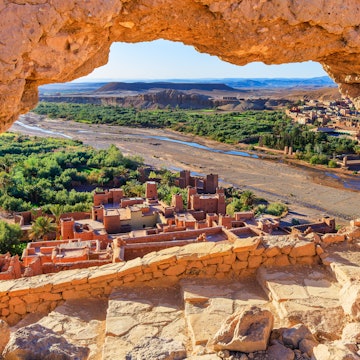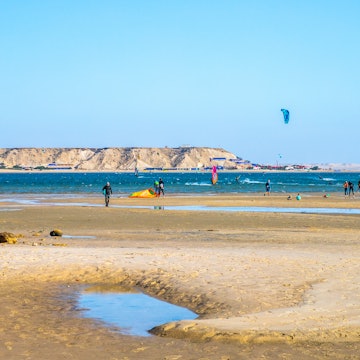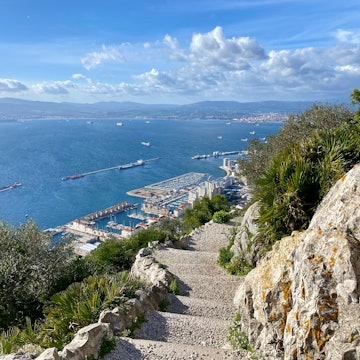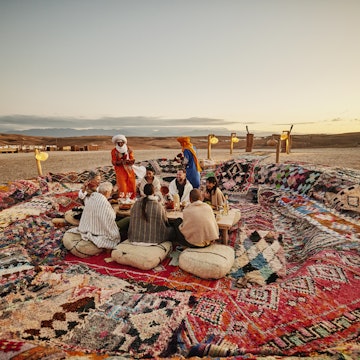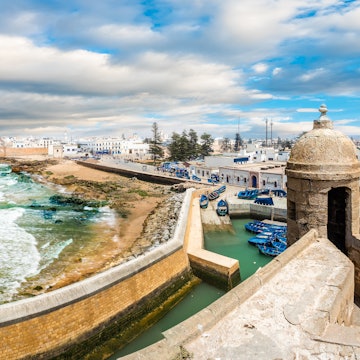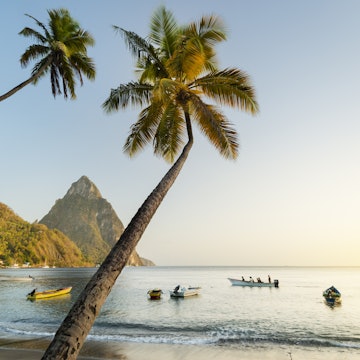

Read on for some local advice before you go to Marrakesh. saaton/Shutterstock
I have lived in Marrakesh full-time for almost 10 years with no intention of leaving. My life in Morocco was colorful, diverse and endlessly inspiring for a curious, creative soul like me. And today the city’s intrigue and magic continues to pull me back.
I will never tire of wandering the tiny alleyways of the Marrakesh medina, stopping for a nouss nouss at Cafe des Epices or gazing at the art deco architecture throughout my Gueliz neighborhood, stepping inside to discover independent art galleries.
Picture-perfect guest houses, and chefs putting a creative spin on local cuisine, are also part of the charm. The design scene in Marrakesh is second-to-none, and in my opinion unique in Morocco as traditional artisans sell their wares alongside contemporary designers, putting a new touch on the traditional techniques and crafts.
A visit to Marrakesh is not about ticking sites off a must-see list but rather meandering – stumbling upon a historic site and watching the world go by from a street-side cafe – the city itself is a sight.
Allow at least three days to see the main historical sites, sample local cuisine and take in a bit of shopping, but design lovers could easily spend a week or more here in Marrakesh.

1. Plan your days prior to arrival
While there is something to be said for spontaneous wanders and chance encounters, Marrakesh is the country’s leading tourist destination and guides, experiences and restaurants book up days, weeks and months in advance in the high season.
Popular sights like La Jardin Majorelle and the nearby Musée Yves Saint Laurent require online advance bookings via their website. To ensure a table at popular restaurants like +61, La Famille and Nomad, book prior to arrival for best availability.
2. Book an airport transfer or catch the local bus
It’s easiest to organize an airport transfer via your accommodation provider for a smooth arrival especially if it is your first visit and your accommodation is hard to find. Taxis from the airport are regulated, so this is a good option if you know where you're going. A city bus also departs frequently from the airport to Djemaa el Fna and destinations throughout Gueliz, but be aware it's cash only.

3. Hone your negotiation skills in advance
From haggling in souqs to negotiating fares with taxis you hail in the street, bargaining is commonplace in Marrakesh. Shopkeepers often state an offer and the buyer is expected to negotiate a price they are prepared to pay. I say: pay what the goods are worth to you. You may find the same item cheaper (or more expensive) elsewhere, but is that worth worrying about? The art of bargaining over a price is all part of the Morocco experience.
Prior to hopping in a cab, negotiate a price in advance if the meter is not activated, or if it (notoriously) doesn’t work. The price within Marrakesh city limits shouldn’t cost more than Dh30 to Dh50 if the meter is activated. Rates are higher at night – and increase based on distance. If the meter does not work, negotiate the price in advance and make sure you have small bills and coins to pay the exact amount agreed (the amount already includes a tip).
4. Be wise about the street food you eat
Some of the best food is served up street side in Marrakesh. When deciding where to eat, consider how many locals are pulling up a seat to tuck into the local delicacy like msemen (pancakes), harira (soup) or a tajine. In Djemaa el Fna, opt for stalls where the food is prepared in front of you.
5. Dress like a local for a comfortable experience
For women, I suggest ditching any belly tops and short shorts while wandering in the Marrakesh medina, one of the city’s most traditional neighborhoods. Instead, opt for dresses that fall below the knee or trousers and a shirt that covers your shoulders.
For men, knee-length shorts or trousers are advised. For traversing the cobblestoned and uneven footpaths, flats are best, ideally close-toed.

6. Carry cash as well as cards
Morocco’s dirham is a closed currency, and visitors are permitted to arrive and leave with a maximum of 1000 dirhams. Most ATMs distribute up to Dh2000 per transaction to a daily maximum of Dh4000 per bank card, although this varies by international bank. Most banks will charge a fee.
7. Don’t avoid visiting Marrakesh just because it’s Ramadan
Don’t be put off by arriving during Ramadan for your trip to Marrakesh. It provides an insight into another aspect of this rich culture. Locals understand that visitors will want to eat and drink, even while out in public. Guides may join you at a table and won’t want you to feel guilty about eating or drinking while they are fasting. However, during this holy month it is even more important that you're mindful about alcohol consumption.

8. Local table manners
When accepting a sample of olives or dates in the souqs, or sharing a tajine with locals, always use and eat with your right hand.
The fanciest places to eat will have a copper basin and a waiter or your host to pour rose- or orange-blossom-scented water from a jug, then hand you a towel. Even the humblest hole-in-the- wall cafe has a sink in the corner with soap and a stack of paper squares for drying. It’s customary to wash your hands at the end of a meal, too.
If invited into a local’s home, arriving with some sweet treats will be graciously received, and bakeries – Amoud, Pâtisserie Amandine and Café 16 – are local favorites.
9. When it comes to love, discretion is key
Sexual relations between non-married Moroccan men and women are not typically flaunted in public. Even though laws around booking a hotel room or self-catering apartment with a Moroccan and non-Moroccan together have reportedly been relaxed, we recommend erring on the side of caution. Discretion is recommended when it comes to showing one’s affection for a partner, regardless of nationality or sexual orientation.

10. Knowing a few words of Darija will earn you points
Though folks working in tourism often speak several languages, with English becoming increasingly common, learning a few words of Darija (Moroccan Arabic) will earn respect.
Walking into a shop, it’s common to greet fellow customers and shopkeepers with an "Assalaamu alaykum" (peace be with you) and respond with “Wa alaykum ssalaam”.
“Chakrun” for thank you, “La chakrun” for no thank you, and “Afak” for please are also key.
11. Problems you may encounter in Marrakesh
Stumbling upon a faux guide either on foot in the medina, or a man on a bike who claims to work at your hotel with offers to visit a "Berber market" or another special, can’t-miss event may result in being led to a family member’s carpet or spice shop. A firm, but polite “no thank you” (“La chakrun”) is often sufficient as you walk confidently in the direction you plan to go.
Try to download a map of the medina before you set out. A paper map can be useful as in some covered streets online maps might not work. While it may cause frustration, getting lost in the Marrakesh medina is part of the fun – until it’s not. If and when this happens, remain confident in where you’re going. Ask an older gentleman in the souqs for directions if necessary. Eventually you'll come across a gate and realise where you are. If you do engage a local lad to show the way, expect to pay for their assistance (Dh20 is reasonable).
Plain-clothes police officers roam the medina frequently and are there to help, taking tourist concerns seriously. A central police station is located in Djemaa el Fna.
12. Keep these must-have items in your day bag
Brushing one’s teeth with tap water is not likely to cause any health issues, but bottled or filtered water for hydrating is recommended. You’ll also want to pack hand sanitizer for days spent wandering, shopping and eating. Always keep a pack of tissues on hand for bathrooms which may not be stocked with toilet paper.
This article was updated from Lonely Planet’s Morocco guidebook, published in November 2025.







